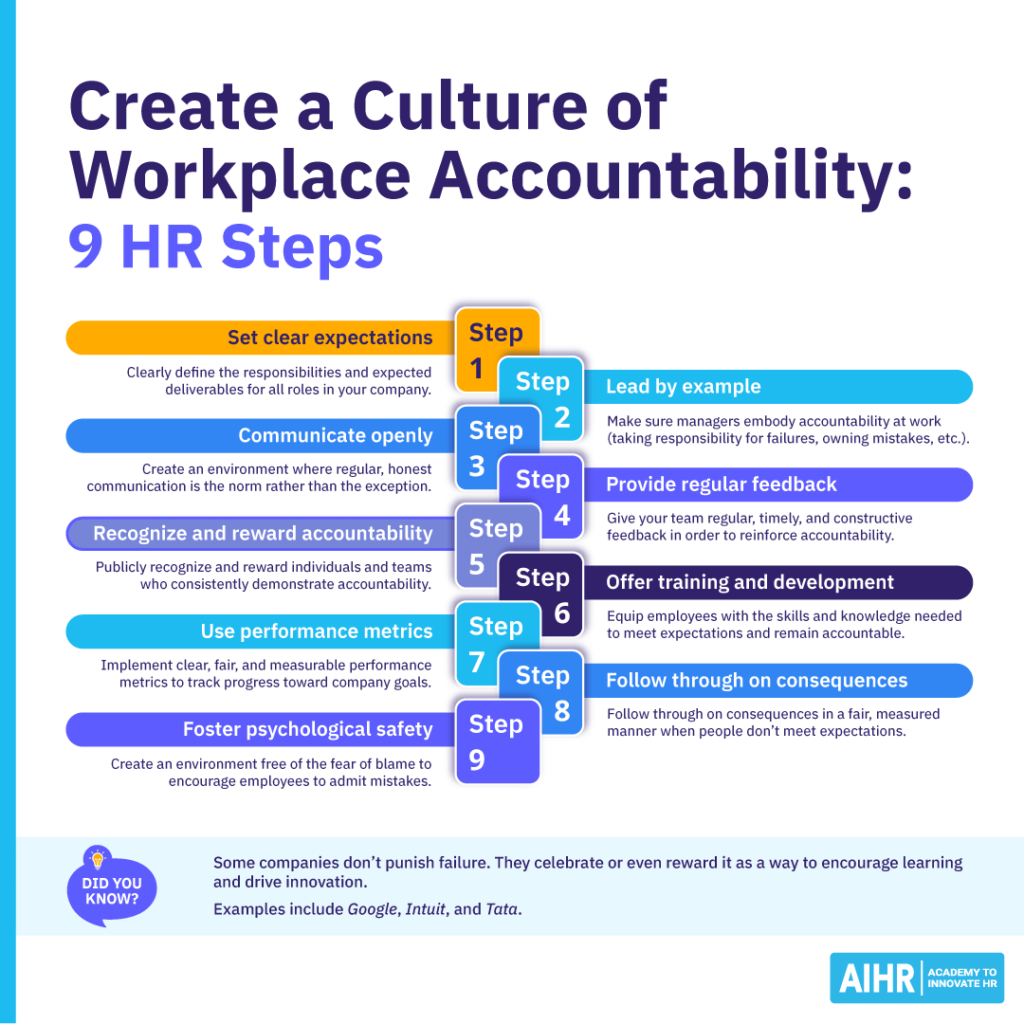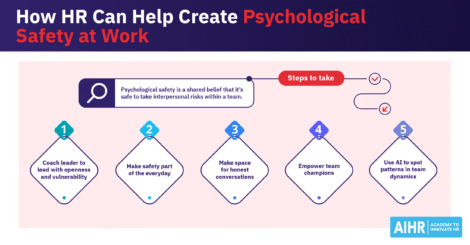Missed deadlines, finger-pointing, and employee disengagement are all tell-tale signs of a lack of accountability in the workplace. Some companies take significant steps to foster workplace accountability — Google rewards employees who take calculated risks and fail, Intuit holds ‘failure parties’, and Tata awards prizes to staff for the Best Failed Idea.
When people take ownership of their roles, feel safe to admit mistakes, and have support in learning from them, they become more proactive and committed. This article discusses why workplace accountability is important, and how you can create a culture of accountability at your organization.
Contents
What is accountability in the workplace?
7 examples of accountability in the workplace
The importance of accountability in the workplace
The impact of a lack of workplace accountability
HR’s role in creating a culture of accountability
9 HR steps to create a culture of workplace accountability
What is accountability in the workplace?
Workplace accountability means individuals owning their actions, choices, and outcomes. It applies to everyone, from junior employees to top leaders.
Accountability shows in three ways:
- Reliability: Delivering on promises and meeting deadlines.
- Integrity: Owning up to mistakes and treating them as learning opportunities.
- Clarity: Being transparent about both successes and setbacks.
Additionally, accountability isn’t just about personal responsibility but also mutual responsibility. Everyone, including managers, should hold one another accountable to high standards.
7 examples of accountability in the workplace
Here are seven examples of professional accountability in action to provide further context for what workplace accountability can look like:
Example 1: A missed deadline
A Marketing Coordinator overlooks an important campaign deadline. Instead of making excuses, they own up to their oversight and directly apologize to their manager. They also promise to put in hours over the weekend to complete their tasks.
Example 2: Leading from the front
Amid slumping sales figures, the company’s Commercial Manager questions their own strategies and team support instead of blaming their team, clients, or the economy. As a result, they develop a revised sales team training plan for a collaborative reset.
Example 3: Giving credit where it’s due
A Project Lead ensures that the spotlight is not just on them when they share and celebrate successes. They acknowledge all team members’ contributions, even those in supporting roles, to celebrate their team’s shared achievements.
Example 4: Double-checking work for accuracy
Before sending a critical financial report to the CFO, an Accounting Specialist takes the extra step of meticulously reviewing their work to catch potential errors before they can become costly realities. This saves their manager the hassle of having to cross-check sub-par work.
Example 5: Executive transparency
In a crucial company address, the CEO explains that a recent business strategy has failed to deliver the intended results. Instead of burying facts or deflecting blame, they explain the situation, accept responsibility for their decision, and outline the plan to handle the issue.
Example 6: The courage to ask
New hire Ben doesn’t understand how to tackle a new and basic task. Instead of bluffing to avoid embarrassment in front of his manager and peers, he seeks clarity by asking direct questions to ensure accurate execution.
Example 7: Extending a helping hand
During peak season, someone sees their colleague struggling to meet their deadlines. Despite also being busy, they step up to offer support and ease their colleague’s burden without expectation of recognition or reward.
The importance of accountability in the workplace
Accountability drives performance, trust, teamwork, and communication, while reducing the need for micromanagement. Here’s how:
- Boosts performance and productivity: Accountability makes employees more invested in their work and its outcomes, leading to higher quality and more efficient results.
- Builds trust between employees and leaders: When everyone, including leadership, is held to the same standards, trust grows, fostering better working relationships.
- Improves teamwork and communication: Clear responsibilities and open communication make collaboration on collective goals smoother and more effective.
- Minimizes micromanagement: Accountable employees need less supervision, allowing managers to empower their teams and giving them no reason to micromanage their staff.
- Cultivates fairness and transparency: Accountability ensures consistency and transparency in expectations and consequences, creating a fair, equitable workplace.
- Encourages continuous improvement: A culture of workplace accountability helps turn mistakes into opportunities for learning and continuous growth.
The impact of a lack of workplace accountability
Not holding your team accountable can harm your entire organization. Without accountability, your organization risks:
- More errors and missed deadlines: Projects can easily derail without clear ownership and follow-through, leading to missed deadlines, inefficiencies, and reputational damage.
- Fractured relationships: When some employees don’t carry their weight, those who do eventually grow resentful, eroding trust, affecting productivity, and creating a tense work environment.
- Toxic behaviors and underperformance: Negative behaviors can spread in an environment where accountability is lacking, harming overall productivity and quality of work.
- Disengagement and talent loss: Employees quickly become disillusioned when poor performance goes unchecked. This leads to low morale, disengagement, and, ultimately, high turnover.
- Erosion of trust in leadership: If leaders don’t uphold accountability or address its absence, employees lose faith in them, as well as in the organization’s values and fairness.
HR’s role in creating a culture of accountability
As an HR leader, you are crucial in shaping your company’s culture and fostering accountability. Here’s a breakdown of your role in workplace accountability:
Identify and bridge accountability gaps
Proactively analyze performance data and gather feedback through town hall meetings, employee surveys, and one-on-one sessions. This will help you pinpoint areas needing attention and enable you to develop targeted solutions.
Equip managers to champion employee accountability
Hire managers who embrace transparency and authentic leadership, and assess their ability to model the right behaviors to foster accountability. Then, train them to define clear expectations, provide feedback, and hold teams accountable.
Build an accountability blueprint
Establish and implement consistent frameworks and processes for goal setting, performance reviews, and resolving performance issues. Be sure to also document these in a handbook or on the company intranet.
Lead by example
HR must lead by example by embodying professional accountability and championing it from the top down. Your actions will set the tone for and reinforce the importance of owning mistakes and results at all levels.
Track and measure impact
Track metrics to assess your accountability initiatives’ impact on key outcomes like productivity, engagement, and turnover. Share your findings to demonstrate the tangible benefits of workplace accountability.
Learn to create an impactful organizational culture
A strong organizational culture naturally builds accountability, encouraging individuals to take ownership of their actions and contributions. With the right skills, you can shape an environment where people thrive and drive lasting success.
AIHR’s Talent Management and Succession Planning Certificate Program teaches you how to implement a culture design process, lead a culture change initiative, and sustain the ideal organizational culture for long-term performance.
9 HR steps to create a culture of workplace accountability
Here’s a nine-step HR roadmap to help you build a culture of accountability in your workplace:
Step 1: Set clear expectations
Clearly define the responsibilities and expected deliverables for all company roles. For example, a marketing specialist needs clear KPIs like lead generation targets, content creation deadlines, and social media engagement goals. Demonstrate how these KPIs impact the number of new customers and the company’s sales revenue.
Step 2: Lead by example
Make sure managers embody accountability at work through their behavior. This means taking responsibility for failures, owning their mistakes, meeting deadlines, and being transparent. The consistency of your company’s managers in this regard sets the standard for the rest of the organization.
Step 3: Communicate openly
Create an environment where regular, honest communication is the norm rather than the exception. This includes clear communication of organizational goals, progress updates, and even challenges experienced. Adhering to this level of transparency builds trust and supports proactive problem-solving.

Step 4: Provide regular feedback
Don’t save your insights for an annual review. Instead, give your team regular, timely, and constructive feedback that’s both positive and developmental. This can reinforce accountability and help employees to understand their impact. It can also enable them to course-correct in real time.
Step 5: Recognize and reward accountability
Publicly recognize and reward individuals and teams who consistently demonstrate accountability. This reinforces positive behaviors and shows the company values those who take ownership. You can create an awards program to reward those who consistently follow through on their promises and deliver excellent results.
Step 6: Offer training and development
Equip your employees with the skills and knowledge they need to meet expectations and remain accountable. Identify training and development needs, and provide growth opportunities to make sure your team has the tools they need to be successful and take ownership of their tasks and results.
Step 7: Use performance metrics
Implement clear, fair, and measurable performance metrics to track progress toward company goals. For example, you can use dashboards that track individual, team, and organizational KPIs. Review them during performance discussions to check progress and identify accountability gaps.
Step 8: Follow through on consequences
Accountability isn’t just about rewards; it also involves addressing shortcomings. When people don’t meet expectations, follow through on consequences in a fair, measured manner. This shows your company takes accountability seriously while also emphasizing fairness and continuous learning.
Step 9: Foster psychological safety
To foster accountability, you must create an environment free of the fear of blame, as this encourages employees to admit mistakes. During team meetings, facilitate open discussions of challenges and mistakes without assigning blame, and propose post-mortem project analyses to identify improvement areas.
To sum up
Creating a strong culture of workplace accountability goes beyond simply preventing mistakes — it’s about empowering employees and managers at all levels to take ownership of their contributions. When done effectively, accountability fosters trust and drives sustainable business success.
By embracing these HR-led strategies, companies can minimize disengagement and transform their environments to foster high performance and lead to positive business outcomes.

















